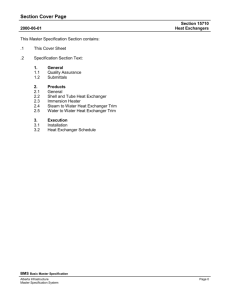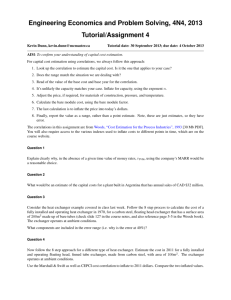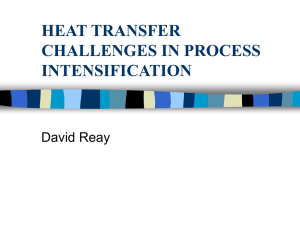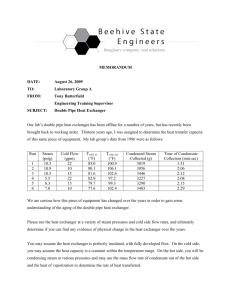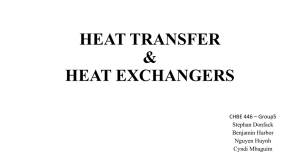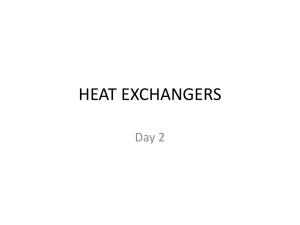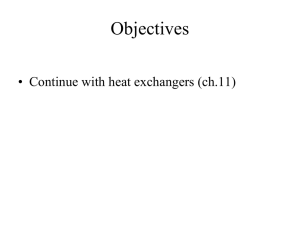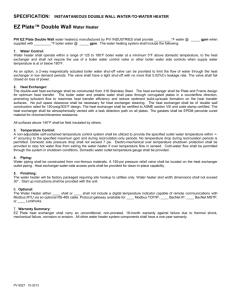Confirm Complex Heat Exchanger Performance
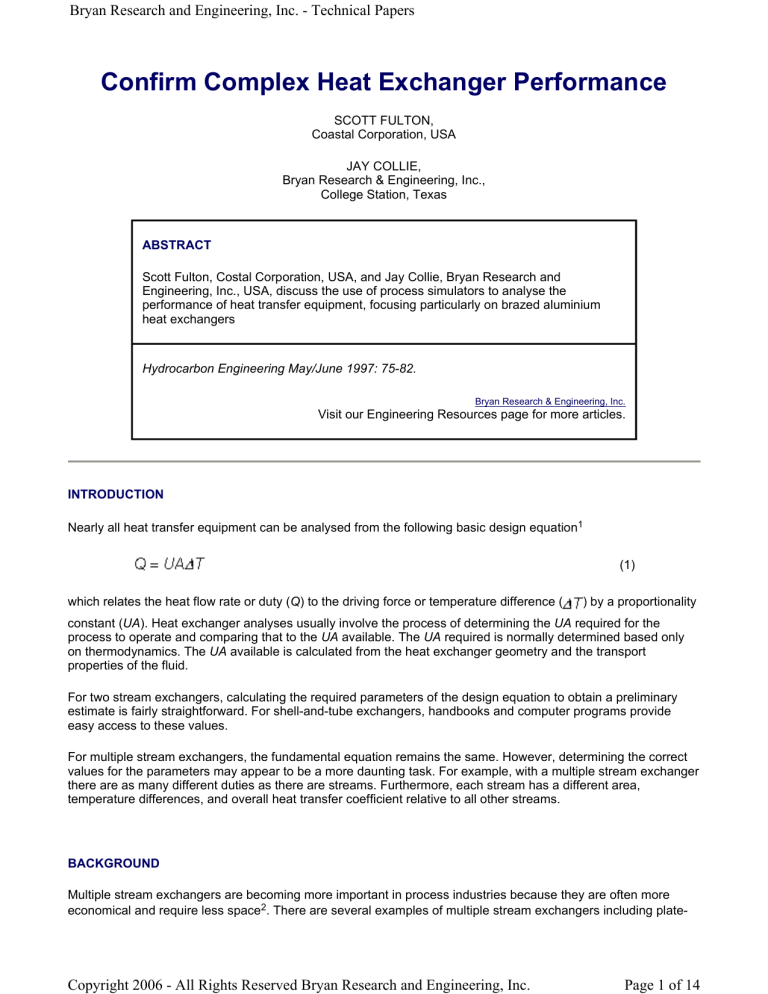
Bryan Research and Engineering, Inc. - Technical Papers
Confirm Complex Heat Exchanger Performance
SCOTT FULTON,
Coastal Corporation, USA
JAY COLLIE,
Bryan Research & Engineering, Inc.,
College Station, Texas
ABSTRACT
Scott Fulton, Costal Corporation, USA, and Jay Collie, Bryan Research and
Engineering, Inc., USA, discuss the use of process simulators to analyse the performance of heat transfer equipment, focusing particularly on brazed aluminium heat exchangers
Hydrocarbon Engineering May/June 1997: 75-82.
Bryan Research & Engineering, Inc.
Visit our Engineering Resources page for more articles.
INTRODUCTION
Nearly all heat transfer equipment can be analysed from the following basic design equation 1
(1) which relates the heat flow rate or duty ( Q ) to the driving force or temperature difference ( ) by a proportionality constant ( UA ). Heat exchanger analyses usually involve the process of determining the UA required for the process to operate and comparing that to the UA available. The UA required is normally determined based only on thermodynamics. The UA available is calculated from the heat exchanger geometry and the transport properties of the fluid.
For two stream exchangers, calculating the required parameters of the design equation to obtain a preliminary estimate is fairly straightforward. For shell-and-tube exchangers, handbooks and computer programs provide easy access to these values.
For multiple stream exchangers, the fundamental equation remains the same. However, determining the correct values for the parameters may appear to be a more daunting task. For example, with a multiple stream exchanger there are as many different duties as there are streams. Furthermore, each stream has a different area, temperature differences, and overall heat transfer coefficient relative to all other streams.
BACKGROUND
Multiple stream exchangers are becoming more important in process industries because they are often more economical and require less space 2 . There are several examples of multiple stream exchangers including plate-
Copyright 2006 - All Rights Reserved Bryan Research and Engineering, Inc.
Page 1 of 14
Bryan Research and Engineering, Inc. - Technical Papers frame, spiral wound, and brazed aluminium. Even the common shell and tube exchanger can be modified to support multiple streams if necessary.
Designing a multiple stream exchanger for a new process should always be left to the vendors who have powerful proprietary models. However, a problem that arises quite often in an operating facility is the analysis of heat transfer equipment for changes in the operating conditions or processing. This type of problem is the motivation for the development of these procedures. Although the concepts of the method for analysing multiple stream exchangers can be applied to any type, the focus of this paper is primarily on the brazed aluminium heat exchanger.
Articles in several publications have documented brazed heat exchangers in the hydrocarbon processing industry 3-5 . These articles describe how these exchangers are used primarily for cryogenic services. Process simulation companies have included exchanger rating utilities to assist engineers in performing preliminary evaluations of exchangers when the conditions of the facility are altered.
MULTISTREAM HEAT EXCHANGER ANALYSIS
The multi-stream heat exchanger analysis method uses thermodynamic principles and transport properties along with the design equation (1) to evaluate the feasibility of an exchanger. The thermodynamics provides the duty and temperature differences, which are used to calculate a required operating criteria as shown in equation (1).
(2)
As becomes small for a given Q , available UA .
becomes large. The transport properties are used to calculate the
(transport relationships) (3)
After performing the necessary calculations, the comparison is made to determine if the exchanger will operate. z z z
There is no excess area.
There is excess area and the exchanger may perform, the outlet temperatures may vary.
There is too little area and the exchanger may not perform.
Fortunately, process simulation programs such as PROSIM
®
6 , which was used in the present work, provide access to most of the parameters needed to perform this comparison even for multi-stream exchangers. Again the important aspect of a multiple stream exchanger analysis is that not only must the whole exchanger be analysed but that each stream of the exchanger should also be considered.
Thermodynamic calculations
Duty and temperature differences can be calculated solely on the basis of thermodynamics.
Duty:
The duty for an individual stream is calculated based on the heat capacity of the stream, any latent heat due to a phase change and, of course, the change in temperature of the stream. The total duty for a complex exchanger is
Copyright 2006 - All Rights Reserved Bryan Research and Engineering, Inc.
Page 2 of 14
Bryan Research and Engineering, Inc. - Technical Papers the sum of the duties of the heating streams or the sum of the duties of the cooling streams. For the exchanger to be in thermodynamic equilibrium, these sums must be equal. This value is easily obtained from the simulation results.
Duty is determined based on information about the inlet and outlet of the exchanger and contains no information about the internals. For the entire exchanger the duty of interest is the total duty of the heating and cooling streams. For the analysis of one stream, the duty of that stream is required.
Temperature difference:
Determining a temperature difference for a multiple stream exchanger is slightly more complex than the duty calculation. Again, most of the mechanics of this calculation are provided by process simulation. Polasek et al.
7 describe how a multi-stream exchanger is reduced to an effective two stream exchanger, one hot stream and one cold stream. With this reduction, calculating the temperature difference for the entire exchanger or a single stream is exactly as if the exchanger was two stream. However, the hot stream must always exceed the cold stream at a given duty if the exchanger is to be thermodynamically consistent.
The temperature difference represents the effective average driving force for the entire exchanger or a single stream relative to the whole. Integral calculus provides the most accurate way to estimate this average driving force and makes no assumptions about the internal temperature profiles except that the exchanger is thermodynamically consistent. This equation is
(4) or the mean temperature difference is obtained by integrating the temperature difference over the duty of the exchanger. If T
H
and T
C
are linear functions of the Q , equation (4) reduces to the familiar log mean temperature difference ( LMTD ). This simplification when applicable means that the effective driving force can be calculated based only on the endpoints (Figure 1).
(5)
T
H
, T
C
, T h
, and T c
refer to the temperatures in Figure 1. In the above example:
= 124.5
o F
Copyright 2006 - All Rights Reserved Bryan Research and Engineering, Inc.
Page 3 of 14
Bryan Research and Engineering, Inc. - Technical Papers
Figure 1. Heat transfer curve -- no phase change.
When a phase change is introduced, as in Figure 2, the temperature profiles are no longer linear across the entire exchanger; however, distinct portions are linear. The duty and associated with these portions may be calculated, and these values can be used to determine for the entire exchanger (6).
(6)
Copyright 2006 - All Rights Reserved Bryan Research and Engineering, Inc.
Page 4 of 14
Bryan Research and Engineering, Inc. - Technical Papers
Figure 2. Heat transfer curve -- phase change.
In the above case:
= 104.9
o F
= 93.1
o F
= 106.6
o
F
Q = 1.827E6 BTU/hr
Q
1
= 1.827E5 BTU/hr
Q
2
= 1.462E6 BTU/hr
Q
3
= 1.827E5 BTU/hr
Therefore = 0.1(104.9) + 0.8(93.1) + 0.1 (106.6) = 95.63
o F.
The same type of simplification can be used to break down a multi-stream exchanger heat transfer curve into more manageable sections. For the analysis of the entire exchanger, the limits of integration span the entire exchanger. For the analysis of one stream, the limits are adjusted to correspond to the entering and exiting temperatures for that particular stream. Figure 3 shows a three stream exchanger composite heat release curve.
Mean temperature differences for each stream are also shown in this graph. Stream A and the entire exchanger have the same effective temperature difference because the duty for stream A spans the entire duty of the exchanger.
= 0.5 (30.5) + 0.5 (18.5) = 24.5
(7)
Copyright 2006 - All Rights Reserved Bryan Research and Engineering, Inc.
Page 5 of 14
Bryan Research and Engineering, Inc. - Technical Papers
Figure 3. Composite heat curve.
If the phase of the stream is changing, the heat curves will become non-linear. In this situation, the most accurate
is estimated by breaking the curve into smaller straight-line segments that approximate the curve (Figure 4).
By calculating a for each of the smaller straight-line segments and weighting them based on the total duty of that pass, a more accurate for the nonlinear segment can be more easily obtained. The smaller the straightline segments on the curve, the more accurate the estimate. Most process simulation tools usually provide this integration in the output, or the data is given such that the numerical integration can be performed via a spreadsheet.
Figure 4. Exchanger 1 -- composite heat curves.
Copyright 2006 - All Rights Reserved Bryan Research and Engineering, Inc.
Page 6 of 14
Bryan Research and Engineering, Inc. - Technical Papers
The for pass B may be calculated from the following formula:
(8)
With the calculated duties and mean temperature differences calculated the UA"" is now determined.
Exchanger configuration and transport relationships
The next step is to determine from the design data and transport relationships. Information required for this process includes the original design or drawings and a procedure for estimating U .
Area:
The area for each side in a brazed aluminium exchanger is determined by the passage length for the side, the passage width for the side, and the type of fin or fins within the layer. This value is typically printed on the manufacturers data sheet, but it is also calculated by PROSIM. Given that all of the layers in a brazed aluminium exchanger are the same width, it is common to think in terms of available and calculated length, rather than areas, when discussing exchanger performance.
For the analysis of the entire exchanger, the area is the sum of the area for all streams. This definition of heat transfer area is different from the two stream shell and tube in which the heat transfer area is based on a single area for one stream.
The overall heat transfer coefficient (U):
The overall heat transfer coefficient includes all of the thermal resistances for the streams and the metal. A complicating factor is the location of these resistances with respect to the heat transfer. For example, both resistances in series and parallel must be considered correctly to estimate a meaningful U . Because of the many effects, this parameter is by far the most difficult to determine accurately.
To begin, the may be expressed as a reciprocal of the thermal resistance R .
(9)
The fundamental components of R include the convective heat transfer coefficient of the fluids and the conductive heat transfer of the metal.
Convection (10)
Conduction (11)
Where h is the convective film coefficient for the stream, A is the heat transfer area for the stream, k is the thermal conductivity of the metal, t is the thickness of the metal and A m is the effective metal area.
Equivalent resistances in series and parallel are calculated by equations (12) and (13) respectively.
Series resistance (12)
Copyright 2006 - All Rights Reserved Bryan Research and Engineering, Inc.
Page 7 of 14
Bryan Research and Engineering, Inc. - Technical Papers
Parallel resistance (13)
For analysis of the entire exchanger, equivalent resistances for the hot streams and cold streams are calculated assuming resistances in parallel. The entire exchanger resistance is then calculated assuming resistances in series for the hot streams, material of construction and the cold streams.
(14)
For an individual stream, a similar procedure is used. The resistance of the stream of interest is determined and the corresponding resistance for the ’other side’ (either hot or cold) is determined.
(15)
Finally for the overall exchanger and
and thermodynamics.
, respectively. Now the
for a given stream is calculated from the reciprocal of
can be compared to the calculated earlier from the
The steps to evaluate a multi-stream exchanger have been presented. This procedure is somewhat tedious but will eventually yield the correct results. For simple exchangers, hand calculations may be possible. The mechanics of the process have historically required the use of both process simulation tools and other calculation techniques: spreadsheets, simple programs, etc. The results presented in these examples were obtained using this method.
Historical complex exchanger rating procedure: z z
Simulate the various design, operating and proposed cases.
Calculate individual ’s for each side. z z
Determine the effective heat transfer area ( A i
) for each stream.
Calculate a total overall heat transfer coefficient for each reference stream ( ). z z z Calculate the (UA) i
of each reference stream.
Compare the calculated (UA) i
with the required UA from .
If required, make process changes to accommodate the available UA and repeat the process.
This evaluation has motivated Bryan Research and Engineering to enhance their exchanger rating package to perform these calculations and analysis for the user. Similar process simulation programs that support these methods could also be used. The current version of PROSIM calculates fluid properties, duty, overall effective
, overall and incremental U , and both the required and available lengths. It also calculates average film heat transfer coefficients, fluid velocity, pressure drop, Reynolds number, heat transfer area, and free flow area for individual sides. Calculated UA s and s for the design case match those on the manufacturer’s data sheets quite well and validate the results of the current version of PROSIM. The enhancements added to the next version and scheduled for release in March-April 1997 include the calculation of effective and required and available lengths for each side. All of the necessary information for a complete evaluation will be provided in a concise, efficient report.
EXAMPLES
The operating plant discussed in this case is a Southwest Texas refinery off-gas processing plant. The inlet gas is
Copyright 2006 - All Rights Reserved Bryan Research and Engineering, Inc.
Page 8 of 14
Bryan Research and Engineering, Inc. - Technical Papers collected from several different refineries, treated, and then fractionated into the various LPG sale products. Since recovery of high purity hydrogen is desired, process temperatures as low as –200 o F are required. To minimise refrigerant use and maximise recovery, brazed aluminium plate-fin heat exchangers are used. A diagram of the process is shown in Figure 5, and the layer relationships are shown in Figure 6.
Figure 5. Diagram of processing plant.
Figure 6. Complex exchanger layer relationships.
A feasibility study was initiated to add processing equipment to produce higher value products which would significantly change the plant feed composition. To ensure that the economics of the project were accurate, the brazed aluminium exchangers were rated for the new process conditions. Replacement of the exchangers could become a major expense if additional surface area or additional refrigeration compression is required.
Copyright 2006 - All Rights Reserved Bryan Research and Engineering, Inc.
Page 9 of 14
Bryan Research and Engineering, Inc. - Technical Papers
METHOD
The following procedure applies basic heat transfer fundamentals to perform a preliminary rating of brazed aluminium plate-fin exchangers. Some readers may not be familiar with certain industry terms such as banking, stacking arrangement, etc. and may wish to consult literature for more information 8,9 . Also, because at least three different operating cases usually need to be considered, and due to the inherent probability that future cases will be considered, a spreadsheet is recommended to perform the calculations.
Getting started
The first step, as in any feasibility study, is to simulate the plant based on the original design and also on current operating conditions. This is critical to ensure that the simulation accurately predicts the plant performance, and to determine the current condition of the exchangers. Great care must be taken when specifying the exchangers themselves, since outlet temperature changes of only 2-3 o F can have a huge impact on the performance of one of these exchangers. For simulation purposes, it is best to specify outlet temperatures only where endpoint approach temperatures are 5 o
F or greater. For endpoint approach temperatures less than 5 o
F, the simulator should calculate the temperature based on a heat balance. Once the simulations have converged and are verified with operating data, the exchangers may be rated.
To perform the rating procedure, the configuration of the exchanger must be known. This includes the stacking arrangement, length of each pass, fin type, and proximity of each stream inlet and outlet relative to the streams with which they exchange heat. To confirm that the configuration is correct, it is recommended that the ’as-built’ drawings be used.
Rating the exchanger
The rating of the exchanger begins with the process simulator, PROSIM. Once the configuration of the exchanger has been specified, the simulator is capable of rating the exchanger based on total length required. This first pass rating gives an indication of the suitability of the exchanger. If the exchanger appears to have sufficient total length and there is no reason to suspect that any individual pass or layer is surface area limited, then the rating of the exchanger is complete. The output of the rating will include total length (both actual and required), as well as individual pressure drops. However, if either the total length is inadequate, or there is a good probability that some of the individual passes could be surface area limited, then a more in-depth evaluation should be performed. A good indicator of potential problems in individual passes is a drastic change in composition that affects the degree of phase change within that stream. This is due to the larger duties required for latent heating (phase change) versus the duty required for sensible heating (simple temperature rise). In fact, further investigation of the surface area was required for the case study presented here.
Determining reference side
The simulator calculates the total heat transfer area for each layer. An effective heat transfer area per unit length, or effective width, is determined by dividing the total heat transfer area of a layer by its total length. This is an important step since the effective heat transfer area must be related back to the reference layer. In Figure 6, if streams A, B, and C are the reference streams, then L
AD
, L
AE
and L
AF are the effective lengths of layers D, E, and
F, respectively, that should be used in the heat transfer calculations for reference stream A.
Also, the distribution areas are not included in the effective lengths since the purpose of these fins is to properly distribute/collect the fluid for entrance/exit to and from the exchanger. Typically, a different fin type is used in this area from that used in the heat transfer area. The heat transfer effect of this area may be estimated if the different fin type and flow direction are taken into account. The manufacturers do not normally include heat transfer in these areas in their calculations.
The selection of the reference side is case specific and completely arbitrary in terms of the accuracy of the calculations. Simplicity is the main criterion for selecting a reference side. By choosing streams A, B, and C as the reference side, the calculation is relatively simple and, since most of the lengths of the other layers span the reference layer, it is easier to determine the total overall heat transfer coefficient for the reference layer.
Copyright 2006 - All Rights Reserved Bryan Research and Engineering, Inc.
Page 10 of 14
Bryan Research and Engineering, Inc. - Technical Papers
Case study
Figure 5 shows a simplified process flow diagram around the exchangers that were evaluated. These brazed aluminium exchangers are probably more complex than most. They contain multiple fin types on a single layer, multiple streams on a single layer, and double and triple banking.
Using the simulator and the method described in the previous sections, the exchangers were evaluated for the original design case as well as three additional cases. The collection of operating data on the exchangers under the current operating conditions was not possible because the schedule did not permit a performance test. Earlier performance tests, however, showed that the exchanger was achieving the design UA s. The results of the evaluation and a discussion of those results are given below.
Evaluation procedure
The version of PROSIM used for the feasibility study could only evaluate the exchanger performance on the basis of the overall length; therefore, calculations were performed using spreadsheets to determine whether sufficient surface area was available on each individual pass. These calculations are required only on one side of the exchanger (i.e. ’hot’ or ’cold’ side). The side of the exchanger containing the shortest lengths was used as a base since the short lengths correspond to the minimum duty required for the pass and do not allow excess surface area to be incorrectly credited to a pass where heat transfer is not feasible at the given temperature.
Description of cases
First, in order to verify the complex exchanger rating procedure, a base case was considered where the solution is known. Once the basis had been set, three different sets of operating conditions were modelled. To completely rate a brazed aluminium exchanger, a full parametric study should be performed over a wide range of possible operating conditions. This will uncover any sensitive areas where a small change in the simulated model might lead to a major process failure in actual practice. However, in the case of the feasibility study, a more limited number of cases proved sufficient to determine what process changes were necessary.
The exchangers were first rated using the original design case. The design rating served as the basis to help ensure that the calculation method was accurate, especially in light of the complexity of the exchangers. The process stream information was taken directly from the design information supplied by the original engineering company to the manufacturer, Altec, for the design of the exchangers. The exchanger geometry was taken directly from their drawings and specification sheets.
Once the design case was rated, three other cases representing different potential operating conditions were rated. The first two cases represent independent sets of operating conditions. The third case is a revised set of conditions based on process and equipment changes suggested from the evaluation of the exchangers in the proposed case 1.
RESULTS
The results showed that the exchangers had a slight excess of surface area in the original design. This was expected since most brazed aluminium exchanger manufacturers typically add a safety factor into the design. A summary of the simulation rating results for all four cases is shown in Table 1.
Table 1. PROSIM rating results - % excess UA .
2
3
Exchanger
Original
Design Case 1 Case 2 Case 3
1 7.23
0.96
7.29
53.00
9.30
(9.24) 7.91
(9.27)
30.72
61.82
14.49
74.43
Copyright 2006 - All Rights Reserved Bryan Research and Engineering, Inc.
Page 11 of 14
Bryan Research and Engineering, Inc. - Technical Papers
Using the results of the PROSIM rating (film heat transfer coefficients and characteristic widths), the available UA for each pass on one side of the exchanger was calculated. Since the area was defined on a per length basis, some of the individual U ’s were weighted for pass length. Summaries of the spreadsheet results for each exchanger are shown in Tables 2-4.
C
B
Pass
A
Table 2. Spreadsheet rating results for exchanger 1 -- summary.
Result
Q
Design
6.2
Case 1
4.6
Case 2
4.5
7.4
5.3
4.9
% excess UA
Q
% excess UA
Q
0.901
7.5
12.2
17.3
0.694
(1.6)
18.5
13.5
1.780
0.802
(7.6)
8.9
11.3
0.610
(22.6)
14.2
15.3
1.660
0.794
(13.5)
9.5
11.0
0.613
(29.0)
14.0
17.8
1.660
Case 3
5.8
8.0
0.825
13.8
8.2
14.0
0.586
0.0
14.0
14.4
1.710
% excess UA 29.9
- degF
78.9
111.0
75.9
- MMBtu/(hr degF)
Q - MMBtu/hr
The % excess UA is based on ( / -1)x100%, () denotes a deficit.
The duties for the design case are 1.1 times the design duty (per manufacturer's specification sheets).
F
Pass
D
E
G
Table 3. Spreadsheet rating results for exchanger 2 -- summary.
Result
Q
Design
2.5
Case 1
2.4
Case 2
1.9
39.0
40.9
40.1
% excess
Q
% excess
Q
% excess
Q
% excess
UA
UA
UA
UA
0.387
(10.9)
6.1
18.4
0.436
31.5
0.0703
9.7
4.5
39.0
0.111
(3.8)
5.3
12.2
0.0656
11.8
3.8
40.9
0.110
18.4
5.7
13.7
0.401
(3.6)
5.0
15.2
0.425
29.2
0.404
(17.1)
5.1
13.7
0.430
15.5
0.645
36.1
3.5
40.1
0.109
24.9
5.8
11.9
Case 3
2.5
37.0
0.402
(5.5)
5.0
15.2
0.429
30.4
0.0672
(0.5)
3.1
37.0
0.110
10.0
5.7
13.4
Copyright 2006 - All Rights Reserved Bryan Research and Engineering, Inc.
Page 12 of 14
Bryan Research and Engineering, Inc. - Technical Papers
Q - MMBtu/hr
- degF - MMBtu/(hr degF)
The % excess UA is based on ( / -1)x100%, () denotes a deficit.
The duties for the design case are 1.1 times the design duty (per manufacturer's specification sheets).
D
C
Pass
B
Table 4. Spreadsheet rating results for exchanger 3 -- summary.
Result Design Case 1 Case 2
Q 5.9
4.1
6.4
15.4
12.7
14.0
% excess UA
Q
% excess UA
Q
0.387
1.0
7.0
14.5
0.537
11.2
5.0
21.7
0.262
0.424
31.3
10.3
23.0
0.664
48.3
3.6
24.8
0.201
0.445
(2.7)
10.3
15.7
0.651
(0.8)
3.4
18.2
0.202
Case 3
4.3
15.3
0.414
47.3
10.7
21.5
0.664
33.4
3.6
23.2
0.201
% excess UA 13.7
- degF
38.5
8.1
29.5
- MMBtu/(hr degF)
Q - MMBtu/hr
The % excess UA is based on ( / -1)x100%, () denotes a deficit.
The duties for the design case are 1.1 times the design duty (per manufacturer's specification sheets).
CASE STUDY CONCLUSIONS
Overall, the results of these ratings indicate the following about each exchanger:
Exchanger 1
The results of the exchanger rating show that this exchanger will be prone to pinch at the -30 o
F point under the new operating conditions. Based solely on thermodynamics (process conditions and duty available), there was an impossible temperature cross within the exchanger. A parallel exchanger for pass B of this exchanger was added to the simulation and material was bypassed until there was no longer a pinch. Subsequent rating showed there were transport problems (insufficient area available), even with the bypass. Consequently more material was bypassed until the available area was sufficient for the required duty.
Exchanger 2
The results of the exchanger rating show no significant pinch points in this exchanger. An exchanger has been added in parallel with this exchanger as a result of a study performed by another engineering firm. A bypass around this exchanger was installed to alleviate a pinch in the cold end of the exchanger. Under the conditions of processing refinery off-gases only, no further refrigeration was required. Under the proposed conditions with new equipment added, however, more refrigeration will be required. This additional refrigeration is necessary because the volume of the warm liquid bypass required would be much greater. The addition of refrigeration here ensures that the product recovery would remain at or very near the recovery under the current conditions (approximately
Copyright 2006 - All Rights Reserved Bryan Research and Engineering, Inc.
Page 13 of 14
Bryan Research and Engineering, Inc. - Technical Papers
95%). Without any additional refrigeration, the product recovery was reduced to below 75%.
Exchanger 3
This exchanger appears to have sufficient surface area under the proposed conditions. While overall duty on this exchanger is essentially unchanged from the design, there will be a significant change in the pass duties. The demethanizer reboiling duty required, for example, has increased from 7 MMBtu/hr to 10.7 MMBtu/hr. Though this is a significant increase, the calculated increases as well, and there is still sufficient area to achieve this increase. Also, there is a trim reboiler available that recovers additional heat. The duties of the other two passes have been reduced while maintaining sufficient s and UA s.
OVERALL CONCLUSIONS
The exchangers rated in the case study were some of the most complicated configurations available. They contained a large number of fluids, multiple fluids on a single layer, multiple fin types on a single layer, and layers of varying lengths. Most of the exchangers in general use will be far simpler in design. With the use of a process simulator like PROSIM, engineers can successfully rate a complex exchanger and confirm their performance before construction begins.
REFERENCES
1. KERN, D.Q., Process Heat Transfer , McGraw-Hill, New York, 1950.
2. LUNSFORD, Kevin M., "Advantages of Brazed Aluminium Heat Exchangers," Hydrocarbon Processing , Vol.
75, No. 7, July 1996, pp 55-63.
3. WEAVER, R.H., "Core-in-Kettle, A Highly Efficient Alternative to Kettle Type Shell-and-Tube," Proceedings of the 72nd Gas Processors Association Annual Convention , San Antonio, TX, March 15-17, 1993.
4. SCHAACK, J.P., "Practical Considerations for Using Brazed Aluminium Heat Exchangers in Natural Gas
Processing and Other Cryogenic Applications," Presented at the Canadian Gas Processors Association Third
Quarterly Meeting, September 11, 1986, Calgary, Alberta.
5. Gas Processors Suppliers Association Engineering Data Book , Vol. I, Section 9, Gas Processors Suppliers
Association, Tenth Edition, 1994, pp 20-30.
6. Bryan Research and Engineering, Inc., PROSIM, copyright 1996.
7. POLASEK, J. C., S.T. DONNELLY, and J.A. BULLIN, "Process Simulation and Optimisation of Cryogenic
Operations Using Multi-Stream Brazed Aluminium Exchangers," The 68th Annual GPA Convention Proceedings ,
1989.
8. The Standards of the Brazed Aluminium Plate-Fin Heat Exchanger Manufacturers’ Association , Brazed
Aluminium Plate-Fin Heat Exchanger Manufacturers’ Association (ALPEMA), ALPEMA, 1994.
9. TAYLOR, M. A., Plate-Fin Heat Exchangers Guide to Their Specification and Use , HTFS Harwell Laboratory,
Oxon, England, 1987. copyright 2001 Bryan Research & Engineering, Inc.
Copyright 2006 - All Rights Reserved Bryan Research and Engineering, Inc.
Page 14 of 14

